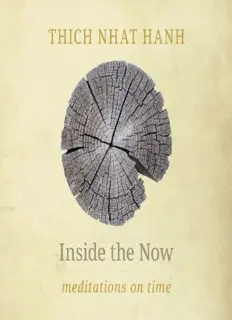
Inside the now : meditations on time PDF
Preview Inside the now : meditations on time
Inside the Now Contents Preface The Way In Now I See Notes Preface I nside the Now is a book in two parts: the first is an autobiographical prologue (The Way In) and the second is a profound contemplation on time, love, and happiness (Now I See). Thich Nhat Hanh wrote this book in the summer of 2013, while he was staying at the European Institute of Applied Buddhism in Waldbröl, Germany. Now I See is an extended free verse poem about time and what it means to be fully present in the here and now. Thay, (as Thich Nhat Hanh is known to his students) takes as his inspiration a series of lines about the passing of time from Vietnam’s most famous epic poem, The Tale of Ki u, in the same way that the thirteenth-century Japanese Zen Master D gen took lines from an earlier Chinese poem as the inspiration for his own great contemplation on time, “Being Time,” (Uji, ). For many readers, this will be the first encounter with The Tale of Ki u, an historical tale that is part romance and part tragedy, set in a medieval era of Confucianism and warlords. It is the story of a beautiful young woman, Ki u, who experiences great love but also suffers immense misfortune and hardship. It is Ki u’s love and her suffering that lead her, ultimately, to deep understanding and insight. Thay has selected a few vivid moments from The Tale of Ki u that reveal something universal about our experience of time, love, and happiness. For readers who are interested, a brief plot summary of The Tale of Ki u and context for the quotes are provided in the Notes. You may have already experienced how in moments of a strong feeling of love—whether it is the love of deep friendship, the love between parents and children, or the love of an intimate relationship—you touch “the now” with greater vividness and intensity. When you can look into a loved one’s eyes, hold one another close, and see and know one another completely, you may feel that time stands still. In Now I See Thay shows us how any moment, including a moment experienced alone with our wonderful planet, can have this same intensity and quality of deep love and connection. Each and every moment is already more beautiful than we could ever have imagined. We just need to learn how to see it. Now I See begins by establishing that there is no such thing as a heaven where everything is pure and blissful. As Thay has often taught, there cannot be a lotus without the mud. In the same way, we cannot have happiness without suffering: happiness is born from understanding and transforming suffering. The wonderful present moment is, therefore, a place where we know how to embrace and understand our suffering and difficulties. Using the eloquent poetry of The Tale of Ki u, as well as that of renowned Zen masters and his own poetry, Thay shows us how important it is to come back to the now in order to truly cultivate joy, take care of suffering, and generate understanding, love, compassion, and insight. Perhaps Thay was inspired by The Tale of Ki u because Ki u’s suffering resonates closely with the suffering that he and his loved ones experienced in Vietnam under decades of colonialism, occupation, violence, and war. Now I See is a kind of lotus that has bloomed from the mud of that suffering. After completing the manuscript for Now I See, Thay wrote the autobiographical introduction, which he called The Way In. It is a “prequel” to Now I See, describing his years in Vietnam from 1949 until his exile in 1966. These were challenging and formative years for Thay, as a young monk, poet, scholar, and community-builder struggling to develop in Vietnam a Buddhism relevant to the suffering of his time. Thay shares intimately about his deep interconnection with his fellow monks and poets, teachers, friends, and students; and we learn how poetry, writing, art, and the close bonds of brotherhood and sisterhood nourished and sustained their spirits. Thay introduces us to those who inspired him, those who supported him, and those whose lives were taken by the ravages of war. The intense experiences of life, love, and loss described in The Way In shine light on the insights into time and interbeing presented in Now I See. Thay’s autobiographic writing reveals how understanding, love, compassion, and insight are not abstract ideas, but energies which can be generated in real-life situations, no matter how difficult they may be. In The Way In Thay shows us how poetry can be both a song of insight and an eloquent voice for change. When one of Thay’s poems was first published in The New York Review of Books in 1966, it dominated the front page and helped foster a national discussion about the terrible costs of war. His indefatigable
